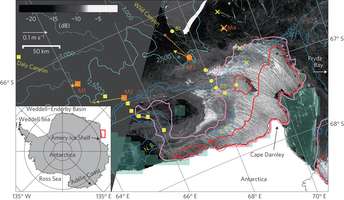Intense sea-ice production in the CDP, revealed from satellite data. Credit: Nature Geoscience (2013) doi:10.1038/ngeo1738
(Phys.org)—An international team of ocean researchers has found a fourth source of Antarctic bottom water (AABW)—the very cold, highly saline layer of water that lies at the bottom of the ocean. In their paper published in the journal Nature Geoscience, the team describes how they discovered the site in the Cape Darnley polynya.
AABW is important because as it moves north from its source, it creates ocean currents that have a major impact on global climate. Until now however, scientists have only been able to identify three major sources—not nearly enough to explain the amount of AABW seen in the ocean. In this new research, the team suspected that a different type of source might be at play—one that came about in a polynya (area of open water that can't freeze over due to rapid wind and water movement), rather than directly offshore of shelf ice. To find out they employed the use of traditional undersea sensors, and less traditionally, sensors attached to the heads of elephant seals.
Ocean currents result from AABW due to the way it's formed. When seawater freezes, much of the salt in the ice is pushed back into the water giving it a very high salinity—and because it's also very cold, it tends to sink. As it hits the bottom it joins other cold water that slowly seeps toward the edge of the continental shelf, where if falls over into the abyss, rather like an under-the-ocean waterfall. That water falling is what generates the currents that flow north.
Researchers had suspected for years that a source for AABW existed somewhere near what they call the Weddell Gyre, but had not been able to find it. In this new research, the team used satellite data to pick a likely polynya, and settled on Cape Darnley. There they sank sensors and studied data supplied by the elephant seal sensors. It was the data from the seals, the researchers report, that showed that areas in which they swam—at times as deep as 1,800 meters—revealed the layer of cold dense water the researchers were looking for—the fourth AABW source.
After analyzing the Cape Darnley polynya source, the researchers have concluded that it is likely responsible for 6 to 13 percent of circumpolar AABW totals, which suggests they say, that other similar sources are out there still waiting to be found.
More information: Antarctic Bottom Water production by intense sea-ice formation in the Cape Darnley polynya, Nature Geoscience (2013) doi:10.1038/ngeo1738
Abstract
The formation of Antarctic Bottom Water—the cold, dense water that occupies the abyssal layer of the global ocean—is a key process in global ocean circulation. This water mass is formed as dense shelf water sinks to depth. Three regions around Antarctica where this process takes place have been previously documented. The presence of another source has been identified in hydrographic and tracer data, although the site of formation is not well constrained. Here we document the formation of dense shelf water in the Cape Darnley polynya (65°–69° E) and its subsequent transformation into bottom water using data from moorings and instrumented elephant seals (Mirounga leonina). Unlike the previously identified sources of Antarctic Bottom Water, which require the presence of an ice shelf or a large storage volume, bottom water production at the Cape Darnley polynya is driven primarily by the flux of salt released by sea-ice formation. We estimate that about 0.3–0.7×106 m3 s−1 of dense shelf water produced by the Cape Darnley polynya is transformed into Antarctic Bottom Water. The transformation of this water mass, which we term Cape Darnley Bottom Water, accounts for 6–13% of the circumpolar total.
Journal information: Nature Geoscience
© 2013 Phys.org





















